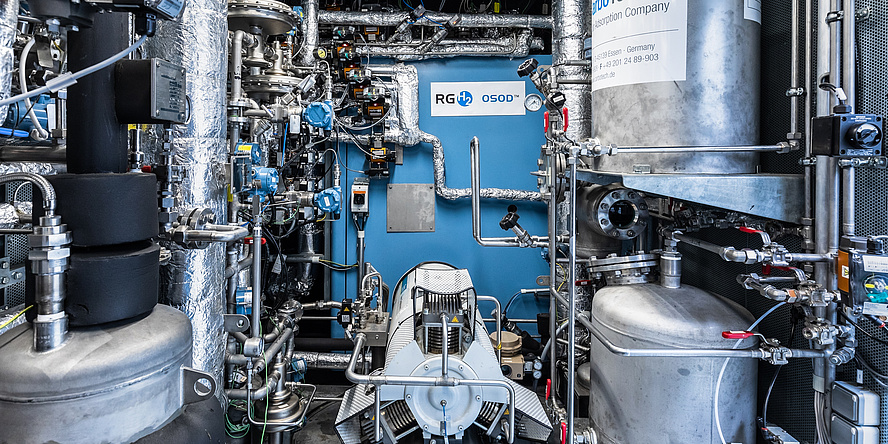May 27 2020
At the Graz University of Technology, hydrogen scientists, in collaboration with the Graz-based start-up Rouge H2 Engineering, have designed an economical process for the decentralized synthesis of high-purity hydrogen.
 The inner workings of the OSOD H2 generator. The blue cuboid is the core development: a gas furnace with four tubular reactors in which the chemical looping process for hydrogen production takes place. Image Credit: © RGH2.
The inner workings of the OSOD H2 generator. The blue cuboid is the core development: a gas furnace with four tubular reactors in which the chemical looping process for hydrogen production takes place. Image Credit: © RGH2.
In the transport industry, hydrogen is an alternative propulsion technology that plays a crucial role in energy transition. But it is not yet appropriate for large-scale production. Hydrogen is mostly synthesized centrally from fossil resources and liquefied or compressed in a valuable and energy-intensive process to be able to deliver it to filling stations.
Moreover, costly infrastructure with high investment charges is required there to store huge amounts of hydrogen.
Research Success Turned into Application
At TU Graz’s Institute of Chemical Engineering and Environmental Technology, the Fuel Cells and Hydrogen Systems Working Group—one of the topmost international groups in the hydrogen research field—has been seeking new approaches to make hydrogen synthesis more attractive.
As part of the Hydrogen Storage via Oxidation and Reduction of Metals (HyStORM) research project, researchers under the guidance of the working group head Viktor Hacker developed what is called a “chemical-looping hydrogen method”—a novel and sustainable process for the decentralized and climate-neutral synthesis of hydrogen.
The success of the award-winning study led to a small and space-saving on-site, on-demand (OSOD) system for energy plants and filling stations. The system is being designed and marketed by Rouge H2 Engineering, a Graz-based start-up.
It is predicted that the new system will turn out to be a crucial piece of the puzzle on the road to the extensive availability of sustainable hydrogen.
How the OSOD System Works
The OSOD system is a hydrogen generator with a built-in storage device in a single system. Hydrogen is generated by transforming natural gas, biomass, or biogas into a syngas. The produced energy is stored in a metal oxide through a redox process (reduction-oxidation process). The metal oxide can be stored and shipped without any safety risks or losses.
The ensuing demand-oriented synthesis of hydrogen is realized by feeding water into the system. High-purity hydrogen is liberated when the iron-based material is charged with steam.
Flexible Scalability
Moreover, this process renders the system attractive for smaller applications.
Current conventional processes for hydrogen production from biogas or gasified biomass require complex and cost-intensive gas purification processes such as pressure swing adsorption—a separation process in which hydrogen is isolated from the gas mixture in several steps.
Sebastian Bock, Hydrogen Researcher, Graz University of Technology
Bock continued, “This works very well on a large scale, but is poorly scalable to smaller, decentralized systems. However, our process generates only high-purity hydrogen through the steam-based redox cycle anyway, so there is no need for any gas purification step at all.”
Therefore, the OSOD system is openly scalable and is specifically appropriate for decentralized applications with low feed-in rates in smaller industrial systems and laboratories, as well as larger decentralized units like hydrogen production from biogas or hydrogen filling stations.
Demand-Oriented Flexibility
Apart from high-purity hydrogen synthesis, Gernot Voitic, lead project manager of R&D at Rouge H2 Engineering, specifies another benefit of the new technology.
The OSOD system can switch to standby mode in the case of low demand and resume hydrogen production at any time if required. This on-demand release and integrated storage is the USP of the OSOD H2 Generator, and sets it apart from other similar products.
Gernot Voitic, Lead Project Manager, R&D, Rouge H2 Engineering
The scientists of TU Graz and Rouge H2 Engineering are already concentrating on the next stage of the study. Currently, the system is only being run on an industrial scale with natural gas. The working group now intends to make it usable for biomass, biogas, and other regionally available raw materials.
For instance, biogas plants could turn out to be even more competitive in the future and, rather than electricity, synthesize green hydrogen, which could be utilized for sustainable mobility ideas.